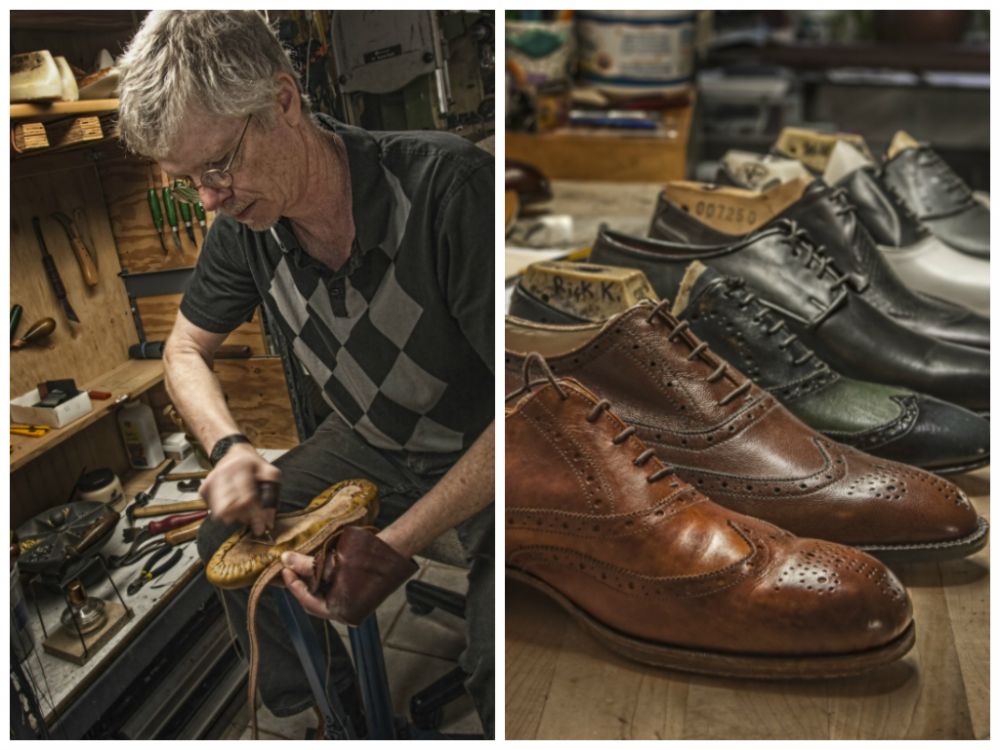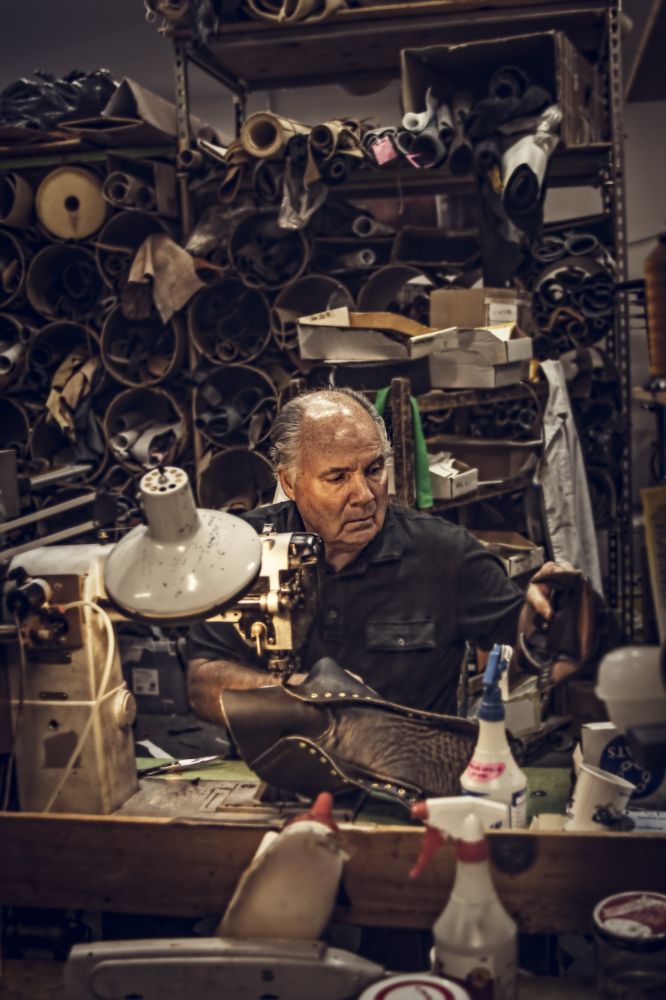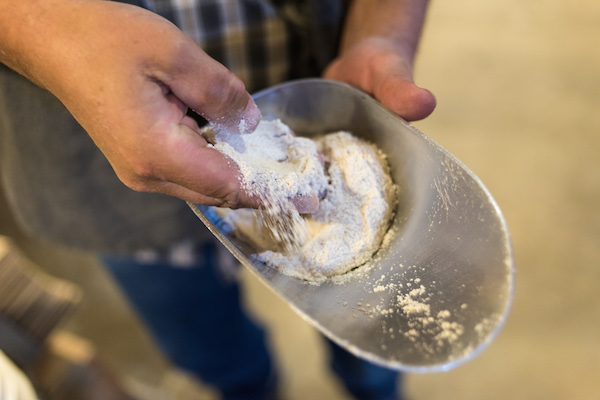photos by Jeff Kennedy
OREGON HAS A LONG AND ILLUSTRIOUS HISTORY IN THE SHOEMAKING INDUSTRY. Home of the footwear giant Nike, the state is also the site of the world’s oldest known shoes, 10,000-year-old sagebrush bark sandals discovered in a cave near Fort Rock, east of Gilchrist. Yet with 99 percent of the footwear on the U.S. market factory-produced overseas, very few people—Oregonian or otherwise—actually know how to construct a pair of shoes with their own two hands.
In the following pages, we introduce five Oregonians practicing one of the world’s oldest, most utilitarian trades. Whether lifelong veterans or newcomers to the craft, these cordwainers fashion boots and shoes for a living, investing forty to sixty hours in each pair and charging between $500 and $7,000.
Some of these shoemakers embrace age-old traditions, while others strive to incorporate new tools and technologies. Regardless of where they fall on the purist-tomodern spectrum, these craftsmen produce footwear that lasts—and, in the process, are preserving a set of skills at risk of being lost forever. >>
D.W. Frommer pulls a wooden cigar box from a shelf in his Redmond shop and flips the top to reveal a bundle of boar bristles and a bar of pine resin. The grey-bearded shoemaker, who works by traditional methods whenever possible, uses the bristles as sewing needles and the resin as wax for his linen thread.
When he was first establishing himself in the trade in the early 1970s, the now sixty-seven- -year-old made a decision that has shaped his entire shoemaking career—to focus on craft rather than money. “You’re not looking for efficiency in making a bespoke shoe,” he says. “You’re looking for quality and excellence.”
Over decades of making cowboy boots and, more recently, high-end dress shoes, Frommer has earned top honors in numerous shoemaking competitions, written several books on boot-making techniques and established an organization called The Honourable Cordwainers’ Company, an online forum for the trade.
His customers range from Great Basin cowboys to European businessmen, and they pay $1,800 to $7,000 for dress shoes and cowboy boots, depending on leather quality and intricacy of design.
Relying mostly on the methods of his predecessors, Frommer achieves impressive results. The sea-green-and-cream-colored cowboy boots made of ostrich and water buffalo, and the high-heeled black lace-ups with the deep red trim, have tight stitches, beautiful lines and subtle, classic colors and designs.
After studying for a few years at the University of Minnesota and serving in the U.S. Army paratroopers in Vietnam, Frommer secured an apprenticeship with a saddle-maker in Albany, Oregon. A few years later, hoping to learn to build shoes himself, he sought the counsel of boot-maker Mike Ives in Billings, Montana.
Frommer studied with Ives for a couple of weeks in 1976, then returned to Oregon and converted the old shed on his property into a small workshop. He began taking orders, even for boots he did not know how to make. “I was always pushing the envelope,” he says.
With more than forty years in the trade, Frommer has watched the shoemaking infrastructure in the United States all but dry up. Most American tanneries folded when shoe production emigrated to Asia. Five U.S. companies produced “lasts”—the foot-shaped models on which cordwainers construct shoes—when he started. Now only Jones & Vining in Arkansas remains. Because most shoemaking resources have been outsourced or are outdated, Frommer orders most of his leathers from Europe and buys replacement hand tools as antiques.
“You can’t have that stuff go away and have the tradition go forward,” Frommer says. “Once the infrastructure is gone, it’s gone forever. All we can do is preserve the tradition through books, articles and examples of good work so sometime after Armageddon, someone can come along and pick it up again.”
On most days, Frommer works on the ground floor of the two-story workshop in his backyard, shaping last forms, sewing insoles and affixing the bottoms of shoes, while his wife, Randee, stitches uppers in the cleaner space upstairs.
“Everyone wants to be an artist, but I don’t,” Frommer says. “I’m happy being a craftsman. To be a craftsman is to do something really well, really painstakingly, with the knowledge that what you do is not only going to last, but it’s going to give satisfaction.”
Rick Roman and Jeff Mandel were working in information technology for a biotech company when they decided they’d had enough of the corporate world. After taking a weeklong course at one of the only shoemaking schools in the country in Port Townsend, Washington, and practicing on their own for several years, they quit their jobs to become shoemakers.
Eight years later, Roman operates Romango Handmade Shoes (that’s Roman plus tango) out of a workshop in his garage in Eugene, and Mandel runs ExIT Shoes (short for “exit information technology”) from a secondfloor workspace in Portland’s Union Station. Both also teach private classes and small workshops.
“It’s very hard to jump in and start making money your first year,” says Roman, 60, who saved money in preparation for his career switch. “You have to have the grace to take the time to develop your skill. It’s been eight years, and I’ve just turned the corner.”
A soft-spoken tango aficionado, Roman has made about 160 pairs of shoes since he began, nearly a third of them leather-soled dance shoes, which sell for $600 a pair, and men’s dress shoes and boots, which range from $950 to $1,200 a pair.
An avid cyclist, Mandel, 47, specializes in 1960s French-style cycling shoes, as well as men’s casual and dress shoes. Constructed of vegetable-tanned leather, Mandel’s designs start at $1,200 and often combine contrasting colors such as red and black or green and tan.
The lack of shoemakers and shoemaking infrastructure in the United States makes learning the trade a constant exercise in self-direction. Roman sought advisors, including D.W. Frommer in Redmond and various professionals in Europe, as he was learning. Mandel continues to study with Dutch shoemakers. Since he began the trade, he has traveled to Europe many times to buy leather and to visit his mentors’ shops with shoe patterns and lists of questions. “In learning, you really are chasing ghosts,” Mandel says. “I will go pretty much anywhere to get answers to my questions.”
While both men base their practice in traditional techniques, they integrate modern technologies as well. A few years ago, Roman created an open-source shoe pattern generator, available to anyone online. Mandel is interested in how he can incorporate modern materials, such as plastics, thermoplastics and adhesives for orthopedic footwear. Before beginning shoe construction, he creates a clear plastic form from the wooden last that he then tests on the customer’s foot for fit.
“It’s important to be equal parts innovation and historical perservation,” Mandel says. “You have to understand how times have changed, and what changes can help you. Not all change is bad.”

“There’s no way she can go buy a pair of shoes,” Crary says, holding up the asymmetrical casts taken of a woman’s feet, from which he’ll create lasts and build shoes. “These people have nowhere else to turn.”
The stepson of Bill Danner of the Danner Boot Company, Crary, 66, was raised among shoemakers. He started working in his stepfather’s Portland shop at age thirteen, cleaning toilets and sweeping floors. He soon sought mentors among his step-father’s employees to teach him how to make moccasins from scratch.
Venturing out on his own in 1978, he founded his own shoe business, a custom shop called Crary Shoes. He fell into the orthopedic niche a year later when a doctor sent him a patient who’d lost multiple toes in an accident. After making molds of the man’s feet, Crary designed a set of lace-up, point-toed cowboy boots. “We put boots on him, and he started crying because he’d thought he was doomed to wearing clunky, potato-looking shoes the rest of his life,” Crary says. “That motivated me.”
Situated in an industrial park near the Portland airport, Crary’s workshop is packed with shelves of foot-shaped lasts, leather skins draped over saw horses and a small army of heavy-duty sewing and finishing machines. Though the place has the mechanical capabilities of a factory, its two employees produce one pair of shoes at a time, to the specifications of the customer.
Crary’s shop still sews shoes by hand, but it has recently begun incorporating technology into last-making and pattern-cutting. Crary now uses a 3-D scanner to create digital images of his customers’ feet and shoe-making software to produce both a form for the last and a design for the shoe. He uses a lathe to convert the last image into a three-dimensional foot form, and a table-sized cutter to hew the pattern out of leather.
“We can do all of that on the computer now and do a much better job—it’s more controllable, more repeatable and more accurate,” Crary says. “My daughter, Meredith, can make a pair of lasts in minutes in the evenings if she likes. In the past, it would take four hours and would wear you out.”
While 70 percent of Crary’s business is creating orthopedic shoes, the other 30 percent is adapting the lines of boots he’s made for thirty years for the Japanese market. (“They like things where you take leather and turn it with the fuzzy side out,” Crary says, amused. “So we do that for them.”)
Though his small operation relies on machinery and international contracts as its mainstay, Crary is an old-fashioned shoemaker at heart. “If you turn out the electricity and give me some leather and wood and hand-tools, I can make shoes,” he says.
As someone who hammered away repairing and making shoes seventy-five hours a week for ten straight years, Bill Shanor knows how backbreaking shoe work can be.
After three decades making and repairing shoes, Shanor opened Bonney & Wills School of Shoemaking & Design in Ashland along with his wife Julie Bonney, about ten years ago. In a large workshop equipped with 3,000 last forms and sixteen sewing machines, he offers seventeen hands-on classes a year—charging $1,475 for one week, $2,475 for two—in subjects such as making moccasins, hiking boots, fashion boots and high heels. Whether students arrive as novices or pros, they create a pair of shoes almost entirely by themselves over the course of the workshop.
“Most people never really get a chance to make something of value with their hands,” Shanor says. “If people get back to the creative experience of making something, they’ll be a lot happier.”
Growing up in his father’s shoe store—a space sandwiched between two department stores in Miami, Florida—Shanor was measuring customers’ feet by the age of twelve. He owned a women’s shoe store and ran a shoe repair and cowboy-boot-making operation in Grants Pass for eighteen years before deciding to branch into men’s and women’s fashion shoes.
“Women’s high heels and men’s high-end dress shoes are harder to make, and they’re richer in variety,” Shanor says. “I like the ability to innovate, and solve problems and make something unique.”
Unlike many of his counterparts in the custom shoemaking field, Shanor does not despise the industrialization that has led to the demise of the shoemaking trade. “It’s just like with cars—if they weren’t mass produced, nobody would be traveling anywhere. If it weren’t for factories, we’d all be running around barefoot,” he says. “All praises to the factories—they create serviceable shoes.”
In his own work, Shanor embraces modern materials and technologies. He uses fiberglass arches and shanks, thermoplastic toe materials, epoxies and adhesives. His shop includes a drill press, an electric nailer and chop saws. “My little force of machines pretty much knocks people over,” says the sixty-eight-year-old cordwainer. “I like making shoes in concert with machinery.”
Shanor has seen a huge resurgence of interest in shoemaking recently. A hundred people from all over the world attend his classes every year, he says.
On a recent Tuesday morning, the five students in his high-heel pump class measured their feet, applied masking tape to their lasts (which they’d later peel off and use to create patterns) and chose the materials they wanted to work with—everything from lavender leather to fauxalligator skin to red fabric with white polka dots.
Many of his students are in awe of their creations, Shanor says. “They don’t believe what they did.”









